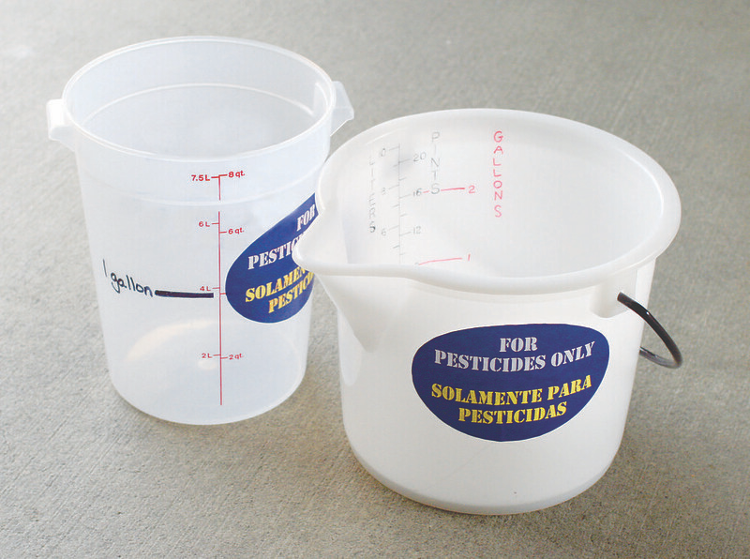
Photo by: Kit Galvin
 Take note
Take note
Pre-marking serves as a visual aid. The bucket used to measure water is marked for 1, 2, and 3 gallons. These were common volumes used to mix pesticides at a greenhouse.
 Idea...
Idea...
A manager thought of this idea when he had difficulty explaining gallon measurements to a handler who only knew the metric system. Instructing the handler to fill to a specific mark improved communications and reduced measurement error.
 Setup & use
Setup & use
- Clearly mark desired volume using permanent black marking pens
- Label each container that will be used only for specific agricultural products. For example, one container will be only for pesticides or only for herbicides use.
- Decontaminate measuring containers after each use.
- Check and replace markings before they wear off.
 Alert
Alert
For accurate measure of dry products, weigh each batch separately. Do not measure additional batches by filling a container up to a mark. Remember, the same volume may have a different weight depending on the size of the dry particles.
 Supplies
Supplies
- Measuring pitchers (clear)
- Black permanent marker
 Tips
Tips
- Use a 2-gallon measuring container for oils to minimize spills and lifting weight.
- Remember to mix pesticides in the proper order.
- Use a different measuring container for each product to prevent cross contamination.
- Provide handlers training on the United States Standard Units for liquids and weights.

Resources
Purdue University Extension
WebMath
Metric Conversions (Spanish)
We hope that you will be inspired you to incorporate solutions into your own training style, develop your own hands-on teaching tools, or discover new practical solutions. We hope that you are inspired to use these solutions in your workplace. Did you try one of the practical solutions or develop a new one? We would appreciate hearing about your ideas and experiences.
Thank you and safe pesticide handling,
PNASH
Contact your state agency for more information on WPS regulations. The content of this website is for informational purposes only. It may need modification to fit your needs or it may not be appropriate for your workplace. Safe use of these solutions is your responsibility. The University of Washington and the Pacific Northwest Agricultural Safety & Health Center is not responsible for any loss or damage resulting from the use of the information provided on this website.
PNASH Project 2016-2021 (CDC/NIOSH Cooperative Agreement # U54 OH007544)
Contact us
Project Email:
PractSol@uw.edu
Project staff:
Maria Tchong-French (habla español)
206 685-6728
